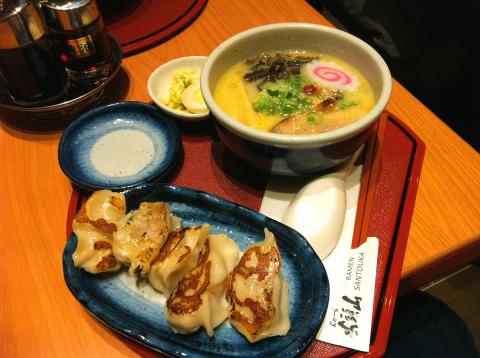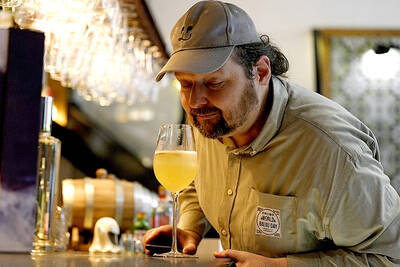If you’re going to visit Hokkaido Ramen Santouka (山頭火), a Japanese ramen chain that just opened its first Taiwanese branch in the basement food court of the Sogo Department Store on Fuxing South Road (復興南路) in Taipei, my first suggestion would be to wear a comfortable pair of shoes. A book to pass the time isn’t a bad idea, either.
Long queues of diners curious about Santouka’s self-declared “legendary” noodle soups have been the norm since the restaurant first opened in early April. The wait can take up to one hour, and the lines rival those of Din Tai Fung (鼎泰豐) at the other end of the hall.
On a visit last week, I thought I would beat the lines by arriving around 11am, when the department store opened. I was wrong. I got there at 11:10am, and already the line consisted of 25 people. It took half an hour before I was seated.

Photo: David Chen, Taipei Times
So is it worth the wait? If you’re a ramen fanatic on a constant search for the perfect bowl, then a trip is in order. I don’t consider myself an aficionado, but it was easy to appreciate the quality of the store’s specialty, the shio ramen (literally salt ramen 鹽味拉麵, NT$190, NT$220 and NT$260 for small, medium and large bowls, respectively). The broth lives up to the marketing hype on Santouka’s Web site: it does indeed taste like it was made from pork bones that had been simmered for 20 hours. The soup is hearty and well balanced, and not overly creamy as the typical Japanese ramen broth tends to be. And the requisite garlic flavor in this concoction is subtle rather than overpowering.
Such attention to detail extended to the rest of the bowl. The noodles tasted fresh and were cooked to a nice chew texture; a few thin slices of bamboo shoots and wood ear mushrooms added some crunch, and a red pickled plum, perched on top like it was a glace cherry on an ice cream sundae, was there for tartness. But what stole the show were the two slices of grilled pork, which melted in the mouth like the classic Chinese dish dongpo pork (東坡肉).
The servings in Santouka’s Shio Ramen are just a tease, though. There’s a deluxe set called toroniku ramen (山頭火特製麵, NT$290, NT$320 and NT$350), which is made from choice cuts of pork jowl meat.
Other noodle soup choices include shoyu ramen (soy sauce broth with noodles, 醬油拉麵)and miso ramen (味噌拉麵), both of which cost NT$190 for a small bowl, NT$220 for a medium and NT$260 for a large. A spicy miso ramen option (辣味噌拉麵) is also available for NT$10 extra.
Santouka recommends a medium-sized bowl for a stand-alone meal. But there is also a wide variety of side dishes, including salmon sashimi salad (鮭魚刺身沙拉, NT$160 for a single order), fried pork cutlet (日式炸豬排, NT$180) and Japanese-style pot stickers (煎餃, NT$160). I ordered the latter and found them to be a nicely done and lighter version of the Northern Chinese variety. They have a thinner skin and are cooked until the bottom is crispy.
These dishes are all available as part of combo sets that come with a small bowl of noodles (your choice of broth flavor) and a boiled egg, with prices ranging from NT$330 to NT$360.

The unexpected collapse of the recall campaigns is being viewed through many lenses, most of them skewed and self-absorbed. The international media unsurprisingly focuses on what they perceive as the message that Taiwanese voters were sending in the failure of the mass recall, especially to China, the US and to friendly Western nations. This made some sense prior to early last month. One of the main arguments used by recall campaigners for recalling Chinese Nationalist Party (KMT) lawmakers was that they were too pro-China, and by extension not to be trusted with defending the nation. Also by extension, that argument could be

Aug. 4 to Aug. 10 When Coca-Cola finally pushed its way into Taiwan’s market in 1968, it allegedly vowed to wipe out its major domestic rival Hey Song within five years. But Hey Song, which began as a manual operation in a family cow shed in 1925, had proven its resilience, surviving numerous setbacks — including the loss of autonomy and nearly all its assets due to the Japanese colonial government’s wartime economic policy. By the 1960s, Hey Song had risen to the top of Taiwan’s beverage industry. This success was driven not only by president Chang Wen-chi’s

Last week, on the heels of the recall election that turned out so badly for Taiwan, came the news that US President Donald Trump had blocked the transit of President William Lai (賴清德) through the US on his way to Latin America. A few days later the international media reported that in June a scheduled visit by Minister of National Defense Wellington Koo (顧立雄) for high level meetings was canceled by the US after China’s President Xi Jinping (習近平) asked Trump to curb US engagement with Taiwan during a June phone call. The cancellation of Lai’s transit was a gaudy

The centuries-old fiery Chinese spirit baijiu (白酒), long associated with business dinners, is being reshaped to appeal to younger generations as its makers adapt to changing times. Mostly distilled from sorghum, the clear but pungent liquor contains as much as 60 percent alcohol. It’s the usual choice for toasts of gan bei (乾杯), the Chinese expression for bottoms up, and raucous drinking games. “If you like to drink spirits and you’ve never had baijiu, it’s kind of like eating noodles but you’ve never had spaghetti,” said Jim Boyce, a Canadian writer and wine expert who founded World Baijiu Day a decade